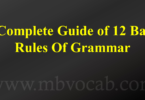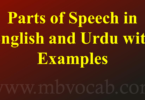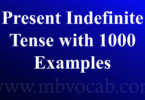Introduction
Welcome to the definitive guide for Deciphering the Enigmas of English Verb Conjugations. English verb conjugations can indeed appear confounding, but have no trepidation! In this exposition, we shall traverse the intricately woven tapestry of grammatical tenses, offering you a profound comprehension of this foundational element of the English lexicon. Prepare to unravel the complexities and ascend to the zenith of grammatical mastery.
Download Now Tenses Book In English And Urdu PDF
Deciphering the Enigmas of English Tenses
English tenses serve as pivotal instruments for delineating the temporal characteristics of actions, occurrences, or states. Let us plunge into the realm of temporal distinctions and scrutinize their profound influence on our communicative prowess.
The Present Tense
The present tense revolves around the unfolding of events in the immediate present. It entails the straightforward depiction of actions or incidents transpiring at the current juncture. For instance, “I am composing articles.”
The Past Tense
The past tense permits us to discourse upon actions or events that have already transpired. It finds utility in recounting past chronicles, such as, “She embarked on a sojourn to Paris last summer.”
The Future Tense
The future tense is the vantage point for actions or events that lie ahead in the temporal continuum. It is dedicated to foreshadowing occurrences, exemplified by, “They shall rendezvous with us on the morrow.”
Present Continuous
The present continuous tense illuminates actions transpiring in the here and now, though they may not necessarily possess permanence. Its formation entails the conjugation of “to be” in the present tense with the present participle, akin to, “He is partaking in luncheon.”
Past Continuous
This particular tense pertains to actions that were in progress during a past epoch but might have since reached their culmination. It is crafted using the past tense of “to be” along with the present participle, such as, “She was diligently engrossed in her studies throughout the night.”
Future Continuous
The future continuous tense signals actions destined to unfold in the forthcoming temporal expanse. Its assembly incorporates the future tense of “to be” alongside the present participle, as exemplified by, “They will be traversing the globe next week.”
Present Perfect
The present perfect tense serves as the conduit between the past and the present. It is the designated vehicle for delineating actions with repercussions echoing into the current moment, as in, “I have concluded my academic tasks.”
Past Perfect
The past perfect tense is the chosen vehicle for narrating actions that were consummated anterior to another past occurrence. Its composition involves the usage of “had” in conjunction with the past participle, as evidenced by, “She had already partaken of her repast when I made my arrival.”
Future Perfect
The future perfect tense earmarks actions slated for completion antecedent to a specified juncture in the future. It encompasses the utilization of “will have” coupled with the past participle, as demonstrated by, “By the advent of the ensuing year, I shall have received my diploma.”
Modal Verbs
Modal verbs, encompassing can, could, may, might, shall, should, will, would, must, and ought to, serve as the vanguards of possibility, necessity, or permission. They hold pivotal significance in articulating the myriad subtleties inherent in English sentences.
FAQs
What is the significance of a comprehensive grasp of English tenses?
A comprehensive understanding of English tenses is pivotal for the art of perspicuous communication. It empowers one to convey not just the occurrence but also the temporal context, thereby refining the precision of one’s discourse.
Do anomalies exist within the realm of English tenses?
Indeed, English tenses do harbor anomalies, irregular verbs, and idiosyncratic rules. Nevertheless, mastery of the fundamentals bestows a firm foundation for addressing these exceptions.
Is it permissible to effectuate transitions between tenses within a solitary sentence or paragraph?
While it remains conceivable to effectuate tense transitions for stylistic purposes, prudence must prevail to avert confounding the reader. Ensuring lucidity in communication should invariably constitute the paramount objective.
Is it obligatory to commit all tenses to memory?
While memorization may serve as a valuable adjunct, comprehending the underlying tenets of tenses proves vastly more advantageous. Once the conceptual framework is assimilated, adept usage becomes markedly more accessible.
How may one enhance one’s command of English tenses?
Practice stands as the quintessential approach. Active engagement in reading, writing, and spoken discourse in English fosters the fortification of one’s grasp of tenses. Consider enrolling in language courses or enlisting the guidance of a tutor if requisite.
What educational resources may be tapped to gain deeper insights into English tenses?
A myriad of tomes, online instructional courses, and language acquisition applications abound to facilitate a deeper exploration of English tenses. Embark on an odyssey through these reservoirs to enrich your erudition.
Conclusion
Deciphering the Enigmas of English Verb Conjugations constitutes an odyssey that every aficionado of language should undertake. By harnessing the intricacies of these tenses, you shall not only refine your expressive prowess but also cultivate a profound reverence for the nuances embedded within the English idiom. Hence, embrace this challenge ardently, engage in unceasing practice, and witness your linguistic proficiency soar to unprecedented heights.







